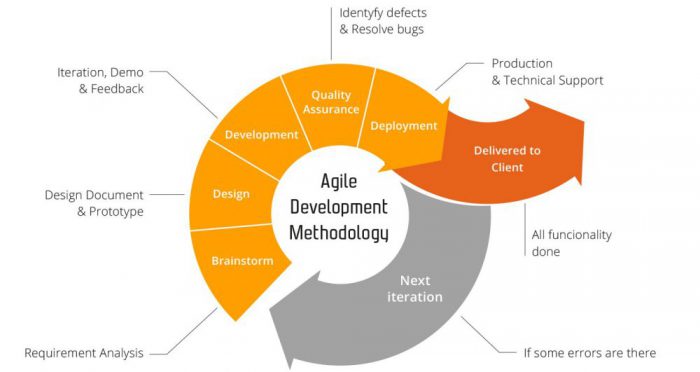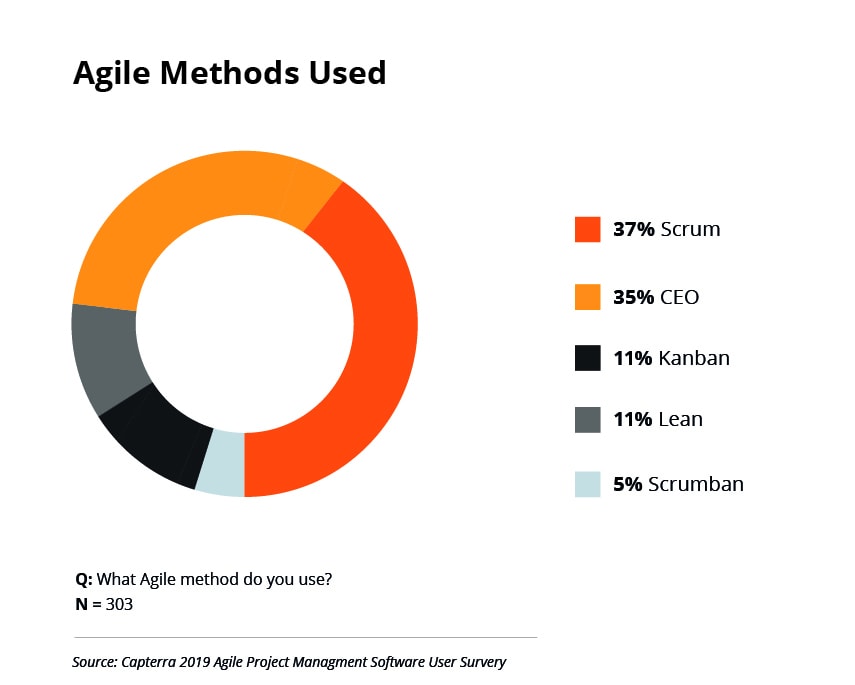
Agile transformation in a nutshell: Getting things done!
In our first article for the Agile series, we discussed how to prepare your company for the Agile transformation. Today, we’re going to take you one step further and give you some tips on how to actually get the job done — the right way.
This article delves into the details of Agile transformation – how it streamlines processes and enhances productivity. We’ll explore the key principles and strategies that make agile projects successful, explaining how to “get things done” in today’s fast-paced and dynamic business landscape.
What is Agile Transformation?
Agile transformations are essentially about an organisation shifting gears to fully embrace Agile methods in project management.
It’s not just a tweak in regular processes and operations; it’s a whole cultural makeover. Imagine everyone, from the development team to the top executives, getting on board with being more flexible, collaborative, and open in their approach.
It starts small, maybe with a pilot project, and gradually, this new way of doing things takes root across the entire company. Successful transformations are not only about people changing; but rather about transforming procedures, technology, and the very structure of the organisation.
It’s a journey, really, evolving over time through repeated cycles and refinements.
Agile in a nutshell: the essential elements
Agile is a game-changer in the world of project management and organisational operations. Let’s break it down into two main ideas: Agile methodology and Agile transformation.
Agile methodology is all about a flexible and collaborative approach to software development and project management. It’s where teams work together, adapt on the fly, and deliver results quickly and efficiently, always ready to respond to change.
The essential elements here include adaptive planning, evolutionary development, early delivery, and continual improvement, with a strong emphasis on customer feedback and small, rapid releases.

Then there’s Agile transformation, which is like taking the Agile way of doing things and making it the heart and soul of an entire organisation.
Agile Transformation strategy: the impact on modern workplaces
Agile transformation strategies are often seen as just a temporary trend, but the truth is that they can have a profound impact on contemporary workplaces.
By adopting an Agile approach, companies can become more adaptable and responsive to the ever-shifting demands of the market and their internal processes.
This, in turn, promotes collaboration, business agility and reduces hierarchy within teams, creating an environment that encourages creativity and employee engagement.
Overall, Agile transformation can increase productivity, improve project outcomes, and enhance workplace dynamics.
Benefits of Agile Transformation
Agile Transformation brings some real perks to the table.
First off, it’s all about better teamwork. By eliminating organisational barriers and streamlining processes, it enables agile teams to work more efficiently and collaboratively towards shared objectives.
Then, there’s this sense of shared purpose that really fires up motivation. In an Agile setup, everyone prioritises important tasks and focuses on the big picture, avoiding getting bogged down in details.
It also puts customers front and centre. Agile companies constantly gather customer feedback and quickly adapt to their wants and needs.
And let’s not forget about the return on investment. Agile organisations tend to do more with less, saving time and resources and often seeing better results.
It’s not just a tech thing anymore; businesses across the board are catching on to how an Agile mindset can really drive growth and profits.

Common challenges of Agile Transformation
Agile transformation brings significant benefits, but it’s not without its challenges.
Here are some of the common hurdles that you can encounter in the process:
Communication Breakdowns: In order to have a smooth transition, effective dialogue is crucial between teams during the successful transformation process.
Resistance to Change: Employees’ reluctance to adopt the Agile approach is a significant challenge. Change can be daunting, and overcoming this resistance is a key step in the transformation.
Lack of Leadership Support: The success of the agile transformation depends on strong commitment and support from all levels of the organisation, including the leadership team.
Unclear Vision and Objectives: Failing to communicate the vision and objectives of the Agile transformation can cause confusion and lack of direction.
Rushing the Process: When a transformation is hurried, it may lead to inadequate backing and a dearth of commitment, which can eventually negatively impact the change process.
Agile Transformation process: 5 tips on how to proceed
Starting an Agile transformation can be a difficult and complex task.
To ensure a successful outcome, here are five crucial tips to help you navigate this process effectively:
1. Create and follow your Agile Transformation roadmap
Follow the steps included in your short-term agenda
Getting started is usually the hardest part of any project. There’s nothing strange about this – you’re facing the unknown. That’s why you need a detailed division of responsibilities and a short-term agenda to always know who is in the decision-making process and what to do next.Adjust your long-term strategy if needed
Getting rid of obstacles is also easier when you have a long-term strategy to guide you through your Agile transformation. However, you may notice that your big plan might need some improvements at some point during the process – that’s totally normal. Flexibility and adjusting to the current situation is what being Agile is all about.Be consistent and committed to your vision
Remember that any temporary disruptions shouldn’t cloud your final vision. You can definitely make modifications along the way – this will help you stay on track – but the key to success in the long run is consistency, commitment and determination in pursuing your goals. So, whenever you need to make a big decision, keep your vision in mind.
2. Set up checkpoints and metrics for executives
Work in intervals
Breaking down the work into smaller chunks will help your team stay focused on specific tasks and make it easier for your managers to evaluate progress.
You can set up a number of checkpoints – for example, you can work in two-week sprints to maintain control over the project and then also have a bigger check-up every 60 or 90 days in order to take a step back and look at things from a wider perspective.Monitor your progress in accordance with the verification model that you’ve created.
Establishing benchmarks and having points of reference is crucial in monitoring your progress. This is where a well-prepared set of metrics comes in handy – you can measure the effectiveness of your Agile transformation, so you know if you’re doing well or if some changes have to be made.
3. Maintain good communication within your teams
Adopt a problem-solving approach
The Agile transformation is usually a big thing that includes a lot of firsts. This, in turn, can potentially cause misunderstandings and create some issues — which can be solved quickly if you approach them with a solution-first attitude.Encourage your team members to give you honest feedback
They shouldn’t be afraid to voice their opinions – whether it’s about a few particular steps of the Agile transformation or the management style.
Honesty, transparency and constructive criticism can only help make the process run more smoothly.Be open to any suggestions
Your C-level executives can come up with some good transformation ideas, as may your other team members — on both the junior and senior levels.
Don’t be too quick to dismiss a suggestion just because it comes from someone with far less experience in this field. A breakthrough pitch can come from the most unexpected sources.
4. Train staff and educate people
Create a common understanding
Make sure that not only your managers but also your other team members share the same understanding of what Agile transformation means for your organisation. This will reduce the number of potential misunderstandings.Organise a meeting or training session, if needed
Talking about things and having discussions is one thing, but it may be more effective to organise a bigger event for all parties involved, where you can share a detailed presentation of the transformation plan, including specific definitions. This will make people feel more comfortable, knowledgeable and secure within the process.Start introducing your Agile transformation to your customers
You can turn the transformation process into a business opportunity and sell it to your clients. Show them how beneficial the transformation will be for them as well, whether you’re preparing a new or upgraded set of products/services for your customers or just transforming your internal processes.
Read more about Software Development and roles of people involved in the process:
5. Don’t stop the process
Focus on finding your weak spots
Regularly infiltrate each and every area of your business. Your company is like a living organism – every part of it changes, matures, and sometimes decelerates and decreases productivity. Stay in control: listen to your employees, monitor the situation, and be ready to react at any time.Remember that the Agile transformation is a continuous process
There is always something to improve and refine. So, even after you’ve accomplished one project, the Agile transformation of your business should continue. Always be searching for new opportunities to develop.
For a successful Agile Transformation, choose the right company!
As you can see – your Agile transformation should be handled in… a very agile way. Follow a plan, but adapt when needed. Monitor your progress, listen to feedback, try to stay open-minded and be ready to make adjustments and further improvements.
Our team at Future Processing has experience in guiding and supporting organisations through their Agile transformation.
We use a unique approach that allows us to closely monitor progress and provide continuous feedback to foster a culture of open-mindedness and improvement. Our goal is to help organisations navigate the complexities of Agile adoption with ease!



